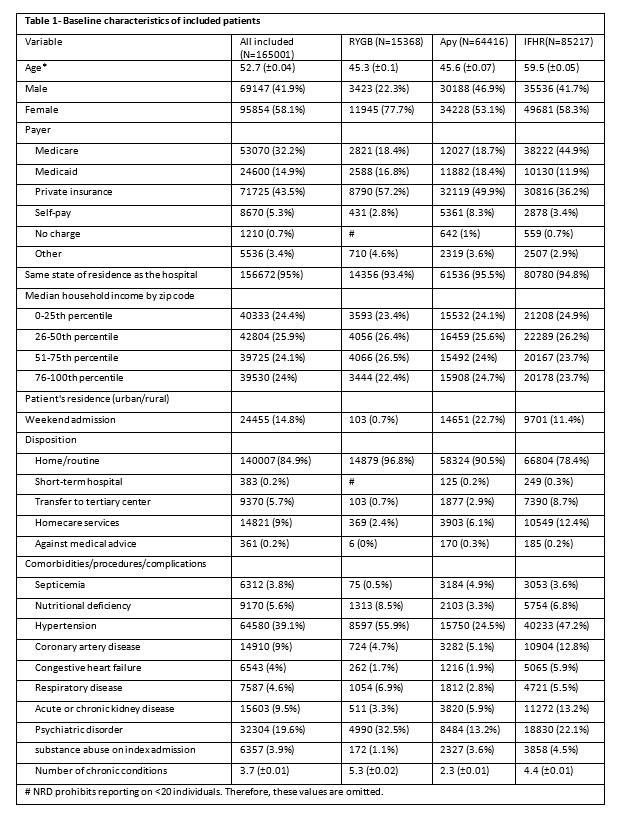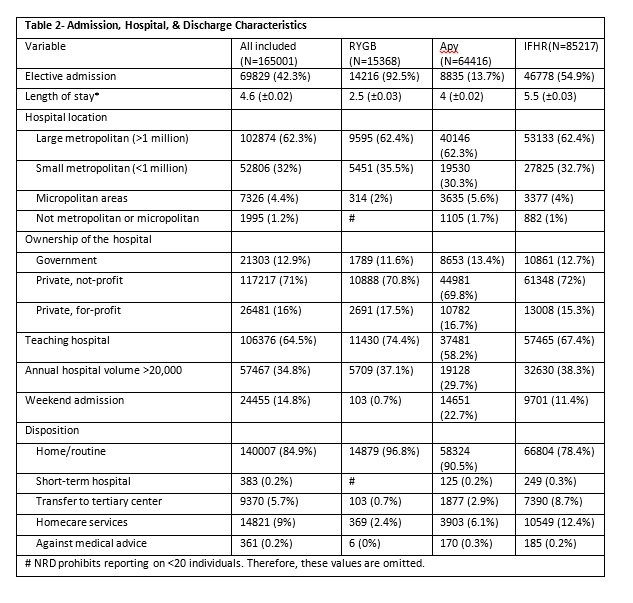ROUX-EN-Y GASTRIC BYPASS SURGERY IS NOT ASSOCIATED WITH EARLY READMISSION FOR SUBSTANCE ABUSE COMPARED TO OTHER ABDOMINAL SURGERIES
Shashank Sarvepalli*1, Zubin Arora2, Madhusudhan R. Sanaka1, Gautam N. Mankaney1
1Gastroenterology, Cleveland Clinic, Cleveland, OH; 2Gastroenterology & Hepatology, Minnesota Gastroenterology, Minneapolis, MN
Introduction
Some patients develop addictive behavior after roux-en-Y gastric bypass (RYGB) surgery. Theories include replacement of excessive eating with substance abuse and post-surgical changes in gastric alcohol metabolism. In this study, we compare the rate of 90-day readmission related to substance abuse in patients after RYGB to appendectomy (Apy) and inguinal or femoral hernia repair (IFHR).
Methods
We interrogated the National Readmission Database (NRD), which contains hospitalization and readmission data of approximately 20% of US hospitalizations, to identify all index hospitalizations where RYGB, Apy, or IFHR were performed in 2014. We excluded hospitalizations with > 1 surgery, surgeries performed in the last three months of the year, patients < 18yo, hospitalizations without length of stay data, and patients who died during index hospitalization. Descriptive statistics were performed. 90 day readmission rate for substance or alcohol abuse was computed for RYGB, Apy, and IFHR and reported as percentages along with standard error. Chi-square analysis was used to assess the significance of the difference. After adjusting for demographic, hospital-related, and clinical characteristics, readmission rates were recalculated with multivariate logistic regression analysis. The analysis was repeated after excluding patients who had known substance abuse disorders on initial admission.
Results
N=165,001 patients were included in the study; 15,368 underwent RYGB, 64,416 underwent Apy, & 85,217 underwent IFHR. Baseline characteristics are described (Table 1). Unadjusted 90-day readmission rate related to substance abuse are 0.33 ±0.05% for RYGB, 0.7 ±0.03% for Apy, and 1.54 ±0.04% for IFHR (P<0.001). After adjusting for characteristics in Table 1, readmission rates are 0.51% (±0.07%) for RYGB, 0.69 ±0.03% for Apy, and 1.45 ±0.04% for IFHR (P<0.001). After excluding 6,357 patients who had substance abuse on index admission, the unadjusted 90-day readmission rate related to substance abuse was 0.24 ±0.04% for RYGB, 0.45 ±0.03% for Apy, 0.87 ±0.03% for IFHR (P<0.001). Adjusted analysis revealed readmission rates of 0.25% (±0.04%) for RYGB 0.41% (±0.03%) for Apy, 0.92% (±0.04%) for IFHR (P<0.001).
Conclusion
Ninety day readmission rates are lower for RYGB than for Apy or IFHR, even after excluding patients with known substance abuse disorders. This suggests a delayed onset for substance abuse and time for preventative strategies following surgical recovery.

Back to 2019 Posters




